A Multicriteria Model to Evaluate Strategic Plans for the Nautical and Naval Industry in Cartagena de Indias, Colombia
Abstract
:1. Introduction
2. Literature Review
3. Methodology
- Identifying the components and elements of the network and their relationships.
- Conducting pairwise comparisons of the elements.
- Placing the resulting relative importance weights (eigenvectors) in pairwise comparison matrices within the matrix (unweighted matrix).
- Conducting pairwise comparisons of the clusters.
- Weighting the blocks of the unweighted matrix, by the corresponding priorities of the clusters, so that it can be column-stochastic (weighted matrix).
- Raising the weighted matrix to limiting powers until the weights converge and remain stable (limit matrix).
- Obtain the elements’ prioritizations according to any of the columns of the limit matrix.
- Once the results are obtained, in case some alternatives achieve very similar results, a sensitivity analysis should be carried out in order to demonstrate the robustness of the ranking obtained.
4. Case Study: Nautical and Naval Industries in Cartagena de Indias, Colombia
4.1. Experts Selection
4.2. Strategies Selection
4.3. Selection of Sustainability Criteria
4.4. Structure of the Decision Problem
4.5. Application of ANP
5. Results
5.1. Results Obtained for the Criteria
5.2. Results Obtained for the Alternatives
6. Discussion
Acknowledgments
Author Contributions
Conflicts of Interest
References
- Iglesias-Campos, A.; Meiner, A.; Bowen, K.; Ansong, J.O. Coastal Population and Land Use Changes in Europe; Elsevier: Amsterdam, The Netherlands, 2015; pp. 29–49. [Google Scholar]
- Cao, W.; Wong, M.H. Current status of coastal zone issues and management in China: A review. Environ. Int. 2007, 33, 985–992. [Google Scholar] [CrossRef] [PubMed]
- Petrosillo, I.; Valente, D.; Zaccarelli, N.; Zurlini, G. Managing tourist harbors: Are managers aware of the real environmental risks? Mar. Pollut. Bull. 2009, 58, 1454–1461. [Google Scholar] [CrossRef] [PubMed]
- Bulleri, F.; Chapman, M.G. The introduction of coastal infrastructure as a driver of change in marine environments. J. Appl. Ecol. 2010, 47, 26–35. [Google Scholar] [CrossRef]
- Di Franco, A.; Graziano, M.; Franzitta, G.; Felline, S.; Chemello, R.; Milazzo, M. Do small marinas drive habitat specific impacts? A case study from Mediterranean Sea. Mar. Pollut. Bull. 2011, 62, 926–933. [Google Scholar] [CrossRef] [PubMed]
- Sierra-Correa, P.C.; Cantera Kintz, J.R. Ecosystem-based adaptation for improving coastal planning for sea-level rise: A systematic review for mangrove coasts. Mar. Policy 2015, 51, 385–393. [Google Scholar] [CrossRef]
- Baser, V.; Biyik, C. The problems and resolution approaches to land management in the coastal and maritime zones of Turkey. Ocean Coast. Manag. 2016, 119, 30–37. [Google Scholar] [CrossRef]
- Papageorgiou, M. Coastal and marine tourism: A challenging factor in Marine Spatial Planning. Ocean Coast. Manag. 2016, 129, 44–48. [Google Scholar] [CrossRef]
- European Commission. Communication from the Commission to The European Parliament, The Council, The European Economic and Social Committee and The Committee of the Regions: A European Strategy for More Growth and Jobs in Coastal and Maritime Tourism; European Commission: Brussels, Belgium, 2014. [Google Scholar]
- International Council of Marine Industry Associations ICOMIA. Recreational Boating Industry Statistics; Liquid Scope Limited: Surrey, UK, 2014. [Google Scholar]
- Ho-Chun, I.; Cheng, F.; Incecik, A.; Carnie, P. Global Marine Trends 2030; Lloyd’s Register Group Limited, QinetiQ and University of Strathclyde: London, UK, 2014. [Google Scholar]
- Brida, J.G.; Pulina, M.; Riaño, E.; Zapata-Aguirre, S. Cruise passengers’ experience embarking in a Caribbean home port. The case study of Cartagena de Indias. Ocean Coast. Manag. 2012, 55, 135–145. [Google Scholar] [CrossRef]
- Ministerio de Comercio Industria y Turismo. Plan Nacional de Turismo Náutico de Colombia: Documento Ejecutivo General; GMN: Madrid, Spain, 2013. Available online: http://asonauticacolombia.com/wp-content/uploads/2015/09/plan-nacional-de-turismo-nautico-de-colombia-20131.pdf (accessed on 13 Febrary 2017).
- Colombia Náutica. Colombia Nautica International Boat Show 2017; Colombia Náutica: Cartagena, Colombia, 2017; Available online: http://colombianautica.co/acerca-de-colombia-nautica/ (accessed on 13 Febrary 2017).
- Moreno-Egel, D.; Agámez, M.; Castro, E.; Voulgaris, G. Beach Morphology and Coastal Protection along Headland Bays in Cartagena de Indias, Colombia. J. Coast. Res. 2006, 2004, 1658–1664. [Google Scholar]
- Comisión Regional de Competitividad de Cartagena y Bolívar. Plan Regional de Competitividad Cartagena y Bolívar 2008–2032; Cámara de Comercio de Cartagena: Cartagena, Colombia, 2010. [Google Scholar]
- Ministerio de Comercio Industria y Turismo. Plan Nacional de Turismo Náutico de Colombia. Fase I: Análisis y Diagnóstico. Costa Caribe; GMN: Madrid, Spain, 2012. Available online: http://www.mincit.gov.co/loader.php?lServicio=Documentos&lFuncion=verPdf&id=64606&name=4._Estudio_de_Turismo_Nautico.pdf&prefijo=file (accessed on 13 Febrary 2017).
- Freeman, M.C.; Whiting, L.; Kelly, R.P. Assessing potential spatial and temporal conflicts in Washington’s marine waters. Mar. Policy 2016, 70, 137–144. [Google Scholar] [CrossRef]
- Gumusay, M.U.; Koseoglu, G.; Bakirman, T. An assessment of site suitability for marina construction in Istanbul, Turkey, using GIS and AHP multicriteria decision analysis. Environ. Monit. Assess. 2016. [Google Scholar] [CrossRef] [PubMed]
- United Nations Economic Commission for Europe UNECE. Convention on Access To Information, Public Participation in Decision-Making and Access To Justice in Environmental Matters; United Nations Economic Commission for Europe UNECE: Aarhus, Denmark, 1998. [Google Scholar]
- European Parliament and of the Council. European Parliament Directive 2003/4/EC; Official Journal of the European Union: Brussels, Belgium, 2003; Available online: http://eur-lex.europa.eu/LexUriServ/LexUriServ.do?uri=OJ:L:2003:041:0026:0032:EN:PDF (accessed on 6 April 2017).
- European Parliament and of the Council. European Parliament Directive 2003/35/EC; Official Journal of the European Union: Brussels, Belgium, 2003; Available online: http://eur-lex.europa.eu/resource.html?uri=cellar:4a80a6c9-cdb3-4e27-a721-d5df1a0535bc.0004.02/DOC_1&format=PDF (accessed on 6 April 2017).
- Le Pira, M.; Ignaccolo, M.; Inturri, G.; Pluchino, A.; Rapisarda, A. Modelling stakeholder participation in transport planning. Case Stud. Transp. Policy 2016, 4, 230–238. [Google Scholar] [CrossRef]
- Loken, E. Use of multicriteria decision analysis methods for energy planning problems. Renew. Sustain. Energy Rev. 2007, 11, 1584–1595. [Google Scholar] [CrossRef]
- Berkes, F. From community-based resource management to complex systems: The scale issue and marine commons. Ecol. Soc. 2006, 11, 45. [Google Scholar] [CrossRef]
- Domínguez-Tejo, E.; Metternicht, G.; Johnston, E.; Hedge, L. Marine Spatial planning advancing the ecosystem-based approach to coastal zone management: A review. Mar. Policy 2016, 72, 115–130. [Google Scholar] [CrossRef]
- Izadikhah, M.; Saen, R.F. A new preference voting method for sustainable location planning using geographic information system and data envelopment analysis. J. Clean. Prod. 2016, 137, 1347–1367. [Google Scholar] [CrossRef]
- Wang, X.; Li, X.R.; Zhen, F.; Zhang, J. How smart is your tourist attraction?: Measuring tourist preferences of smart tourism attractions via a FCEM-AHP and IPA approach. Tour. Manag. 2016, 54, 309–320. [Google Scholar] [CrossRef]
- Kovačić, M. Selecting the location of a nautical tourism port by applying promethee and gaia methods case study—Croatian northern adriatic. Promet Traffic Transp. 2010, 22, 341–351. [Google Scholar] [CrossRef]
- García-Melón, M.; Gómez-Navarro, T.; Acuña-Dutra, S. An ANP approach to assess the sustainability of tourist strategies for the coastal national parks of Venezuela. Technol. Econ. Dev. Econ. 2010, 16, 672–689. [Google Scholar] [CrossRef]
- Ginevičius, R.; Podvezko, V. Evaluating the changes in economic and social development of Lithuanian counties by multiple criteria methods. Balt. J. Sustain. 2009, 15, 418–436. [Google Scholar] [CrossRef]
- Saaty, T.L. How to make a decision: The analytic hierarchy process. Eur. J. Oper. Res. 1990, 48, 9–26. [Google Scholar] [CrossRef]
- Ramzan, N.; Degenkolbe, S.; Witt, W. Evaluating and improving environmental performance of HC’s recovery system: A case study of distillation unit. Chem. Eng. J. 2008, 140, 201–213. [Google Scholar] [CrossRef]
- Sólnes, J. Environmental quality indexing of large industrial development alternatives using AHP. Environ. Impact Assess. Rev. 2003, 23, 283–303. [Google Scholar] [CrossRef]
- Šijanec, M.; Žarnić, R.; Šelih, J. Multicriterial sustainability assessment of residential buildings. Technol. Econ. Dev. Econ. 2009, 15, 612–630. [Google Scholar] [CrossRef]
- Strojny, J. Implementation of the AHP and Benchmarking in Strategic Analysis of Polish Regions. Proc. Soc. Behav. Sci. 2015, 213, 229–235. [Google Scholar] [CrossRef]
- Akbari, N.; Irawan, C.A.; Jones, D.F.; Menachof, D. A multi-criteria port suitability assessment for developments in the offshore wind industry. Renew. Energy 2017, 102, 118–133. [Google Scholar] [CrossRef]
- De Lotto, R.; Gazzola, V.; Gossenberg, S.; Morelli di Popolo, C.; Venco, E.M. Proposal to Reduce Natural Risks: Analytic Network Process to Evaluate Efficiency of City Planning Strategies; Springer: Cham, Switzerland, 2016; pp. 650–664. [Google Scholar]
- Wu, X.; Cui, P. A Study of the Time–Space Evolution Characteristics of Urban–Rural Integration Development in a Mountainous Area Based on ESDA-GIS: The Case of the Qinling-Daba Mountains in China. Sustainability 2016, 8, 1085. [Google Scholar] [CrossRef]
- Saaty, T.L. The Analytic Network Process: Decision Making with Dependence and Feedback; RWS Publications: Pittsburgh, PA, USA, 2001. [Google Scholar]
- Sipahi, S.; Timor, M. The analytic hierarchy process and analytic network process: an overview of applications. Manag. Decis. 2010, 48, 775–808. [Google Scholar] [CrossRef]
- Peris, J.; García-Melón, M.; Gómez-Navarro, T.; Calabuig, C. Prioritizing Local Agenda 21 Programmes using Analytic Network Process: A Spanish Case Study. Sustain. Dev. 2013, 21, 338–352. [Google Scholar] [CrossRef]
- Bottero, M.; Mondini, G. An appraisal of analytic network process and its role in sustainability assessment in Northern Italy. Manag. Environ. Qual. Int. J. 2008, 19, 642–660. [Google Scholar] [CrossRef]
- Saaty, T.L.; Peniwati, K. Group Decision Making : Drawing out and Reconciling Differences; RWS Publications: Pittsburgh, PA, USA, 2008. [Google Scholar]
- Shiau, T.A.; Chuen-Yu, J.K. Developing an indicator system for measuring the social sustainability of offshore wind power farms. Sustainability 2016, 8, 470. [Google Scholar] [CrossRef]
- Ka, B. Application of fuzzy AHP and ELECTRE to China dry port location selection. Asian J. Shipp. Logist. 2011, 27, 331–354. [Google Scholar] [CrossRef]
- Wang, Y.; Jung, K.-A.; Yeo, G.-T.; Chou, C.-C. Selecting a cruise port of call location using the fuzzy-AHP method: A case study in East Asia. Tour. Manag. 2014, 42, 262–270. [Google Scholar] [CrossRef]
- Feng, L.; Zhu, X.; Sun, X. Assessing coastal reclamation suitability based on a fuzzy-AHP comprehensive evaluation framework: A case study of Lianyungang, China. Mar. Pollut. Bull. 2014, 89, 102–111. [Google Scholar] [CrossRef] [PubMed]
- Shafiee, M. A fuzzy analytic network process model to mitigate the risks associated with offshore wind farms. Expert Syst. Appl. 2015, 42, 2143–2152. [Google Scholar] [CrossRef]
- Deluka-Tibljaš, A.; Karleuša, B.; Šurdonja, S.; Dragičević, N. Use of AHP Multi-Criteria Method for Transportation Infrastructure Planning. In Proceedings of the International Scientific Conference: People, Buildings and Environment, Kroměříž, Czech Republic, 15–17 October 2014. [Google Scholar]
- Erdoǧmuş, S.; Aras, H.; Koç, E. Evaluation of alternative fuels for residential heating in Turkey using analytic network process (ANP) with group decision-making. Renew. Sustain. Energy Rev. 2006, 10, 269–279. [Google Scholar] [CrossRef]
- Ulutaş, B.H. Determination of the appropriate energy policy for Turkey. Energy 2005, 30, 1146–1161. [Google Scholar] [CrossRef]
- Kao, L.-S.; Chiu, Y.-H.; Tsai, C.-Y. An Evaluation Study of Urban Development Strategy Based on of Extreme Climate Conditions. Sustainability 2017, 9, 284. [Google Scholar] [CrossRef]
- García-Melón, M.; Gómez-Navarro, T.; Acuña-Dutra, S. A combined ANP-delphi approach to evaluate sustainable tourism. Environ. Impact Assess. Rev. 2012, 34, 41–50. [Google Scholar]
- Gómez-Navarro, T.; García-Melón, M.; Acuña-Dutra, S.; Díaz-Martín, D. An environmental pressure index proposal for urban development planning based on the analytic network process. Environ. Impact Assess. Rev. 2009, 29, 319–329. [Google Scholar] [CrossRef]
- Chen, S.H.; Chen, C.M.; Lee, H.T. Tourism development planning using analytic network process. Int. J. Leis. Tour. Mark. 2009, 1, 70–86. [Google Scholar] [CrossRef]
- Wolfslehner, B.; Vacik, H. Evaluating sustainable forest management strategies with the Analytic Network Process in a Pressure-State-Response framework. J. Environ. Manag. 2008, 88, 1–10. [Google Scholar] [CrossRef] [PubMed]
- Wang, W.-M.; Lee, A.H.I.; Chang, D.-T. An integrated FDM–ANP evaluation model for sustainable development of housing community. Optim. Lett. 2010, 4, 239–257. [Google Scholar] [CrossRef]
- Pourebrahim, S.; Hadipour, M.; Bin Mokhtar, M.; Mohamed, M.I.H. Analytic network process for criteria selection in sustainable coastal land use planning. Ocean Coast. Manag. 2010, 53, 544–551. [Google Scholar] [CrossRef]
- Hasanzadeh, M.; Danehkar, A.; Azizi, M. The application of Analytical Network Process to environmental prioritizing criteria for coastal oil jetties site selection in Persian Gulf coasts (Iran). Ocean Coast. Manag. 2013, 73, 136–144. [Google Scholar] [CrossRef]
- Hasanzadeh, M.; Danehkar, A. Environmental site selection for oil jetty using the analytical network process method case study: Boushehr, Iran. Ocean Eng. 2014, 77, 55–60. [Google Scholar] [CrossRef]
- Najafinasab, F.; Karbassi, A.R.; Ghoddousi, J. Fuzzy analytic network process approach to evaluate land and sea criteria for land use planning in coastal areas. Ocean Coast. Manag. 2015, 116, 368–381. [Google Scholar] [CrossRef]
- López, L.F.; Amezquita, J.; Sáenz, J.; Angulo, G.; Ramos, G. Serie Avances de Investigación 12: Brechas de Capital Humano en el Clúster Náutico de Cartagena; Cámara de Comercio de Cartagena: Cartagena, Colombia, 2015; Available online: http://www.cccartagena.org.co/sites/default/files/2015051223_inv_serie_avances_de_investigacion_bch._no._12_v2.pdf (accessed on 14 December 2016). (In Spanish)
- Corporación de Ciencia y Tecnología para el desarrollo de la industria naval, marítima y fluvial COTECMAR. Informe de gestión 2015; Cotecmar: Cartagena, Colombia, 2016; Available online: http://www.cotecmar.com/sites/default/files/descargas/Informe%20de%20Gestion%202015.pdf (accessed on 24 Febrary 2016). (In Spanish)
- Alcaldía Distrital de Cartagena de Indias D. T. y C. Plan de Desarrollo “Primero la Gente” 2016–2019; Alcaldía Distrital de Cartagena de Indias: Cartagena, Colombia, 2016. Available online: http://www.siipe.co/wp-content/uploads/2014/08/Plan-Cartagena.pdf (accessed on 24 October 2016). (In Spanish)
- Alcaldía Distrital de Cartagena de Indias D. T. y C. Plan Sectorial del Turismo de Cartagena de Indias; Alcaldía Distrital de Cartagena de Indias: Cartagena, Colombia, 2014. Available online: http://sigob.cartagena.gov.co/Pd2016/Anexo%206%20Plan%20Sectorial%20de%20Turismo.pdf (accessed on 24 October 2016). (In Spanish)

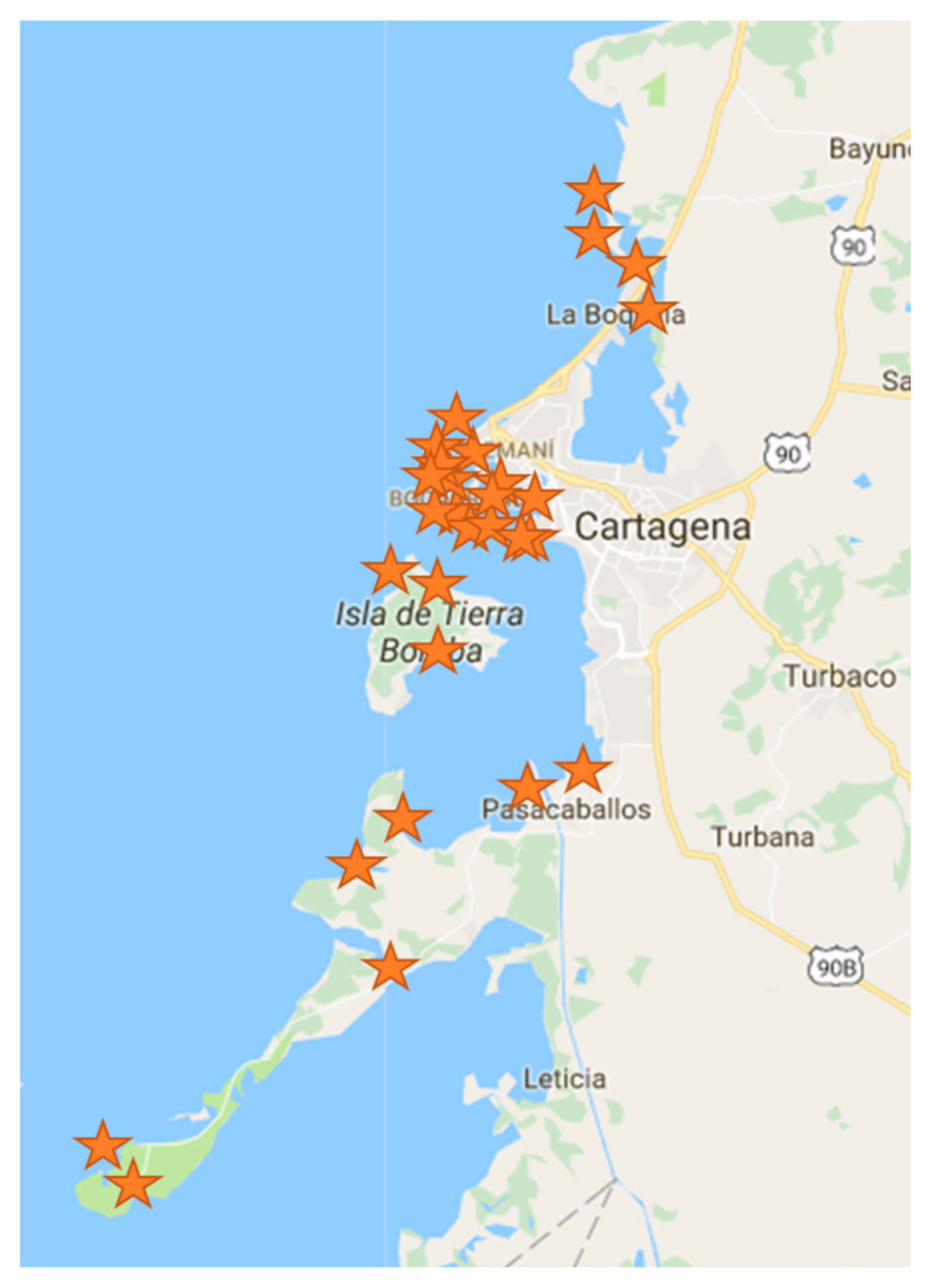
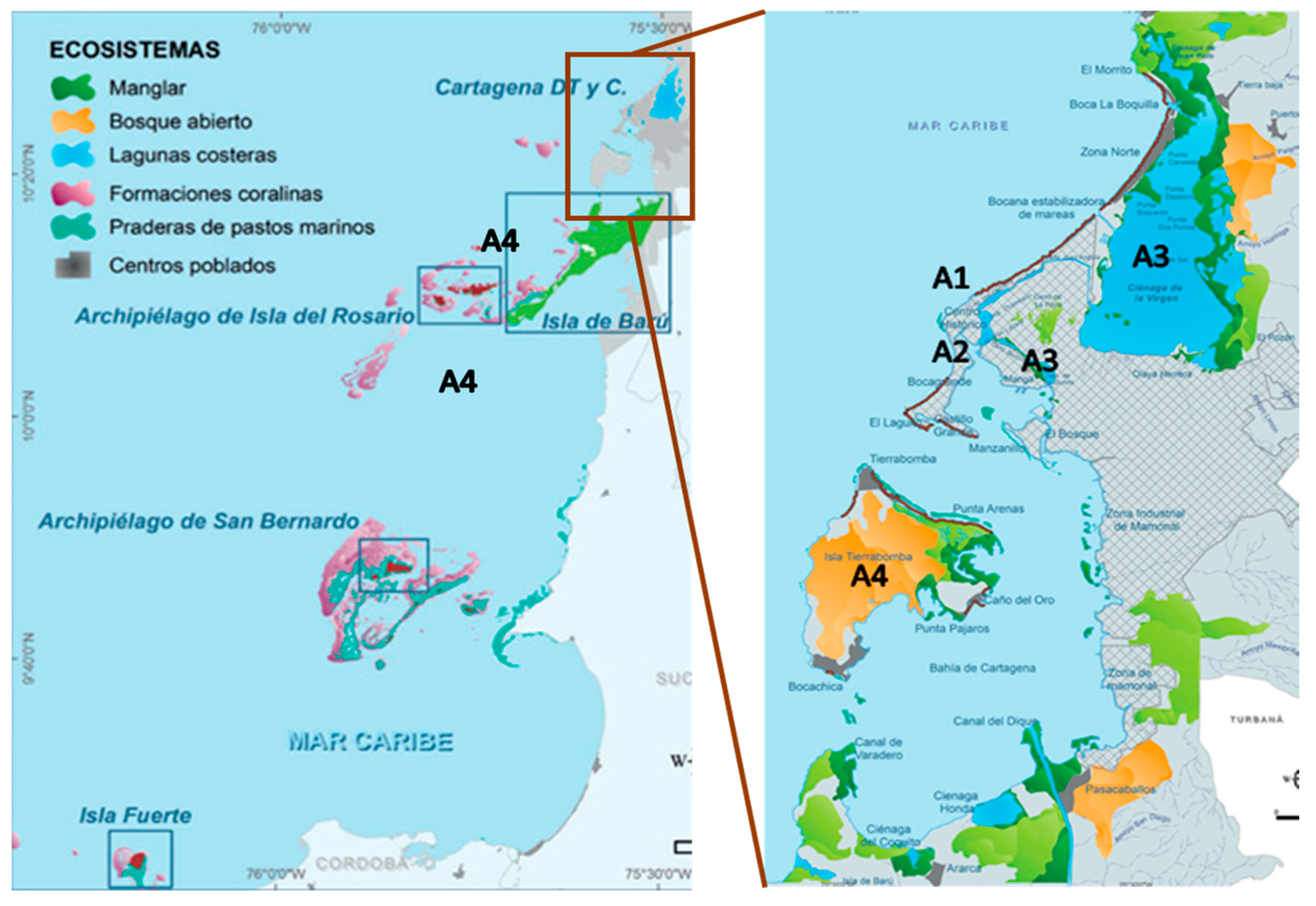
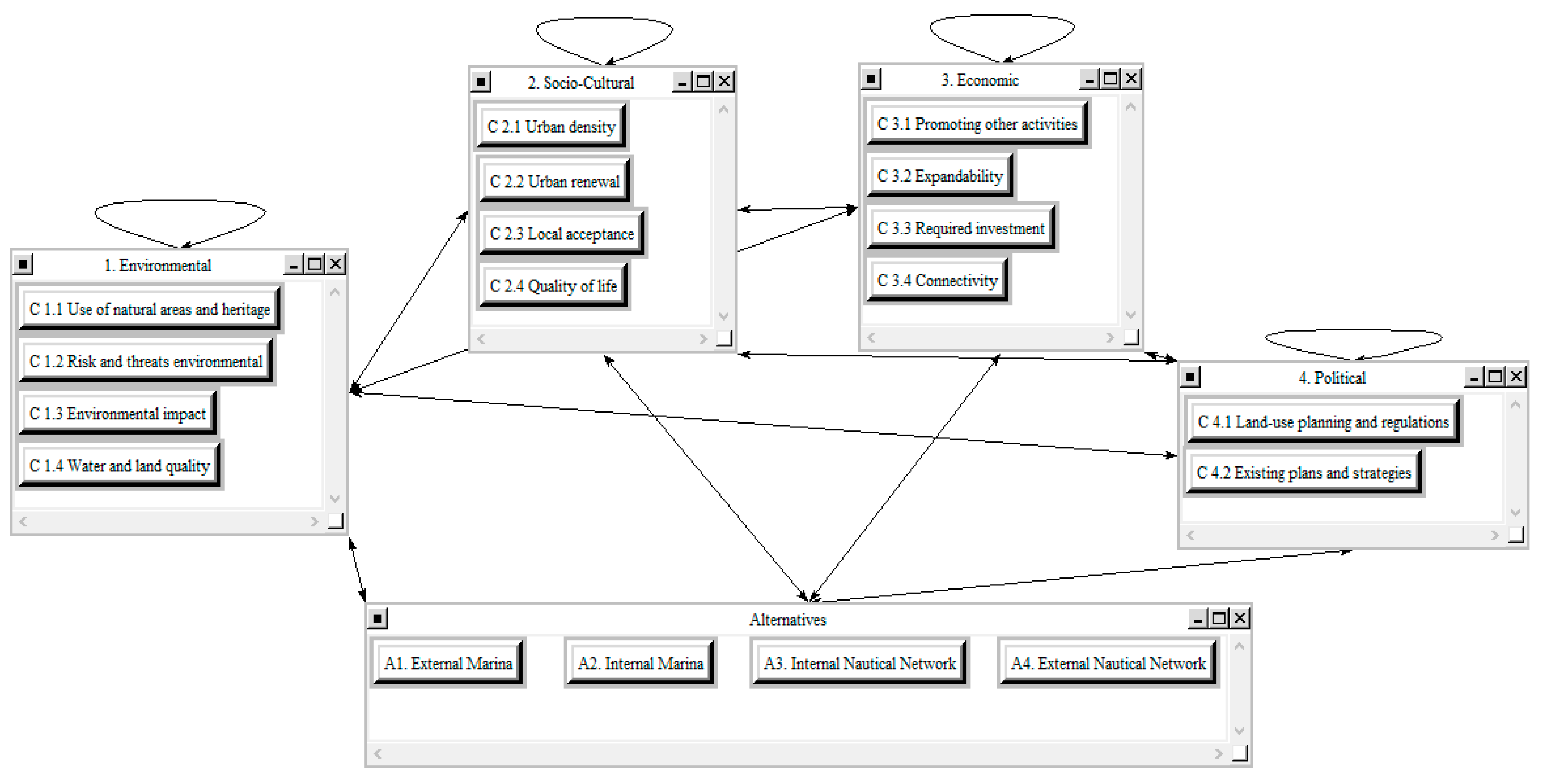

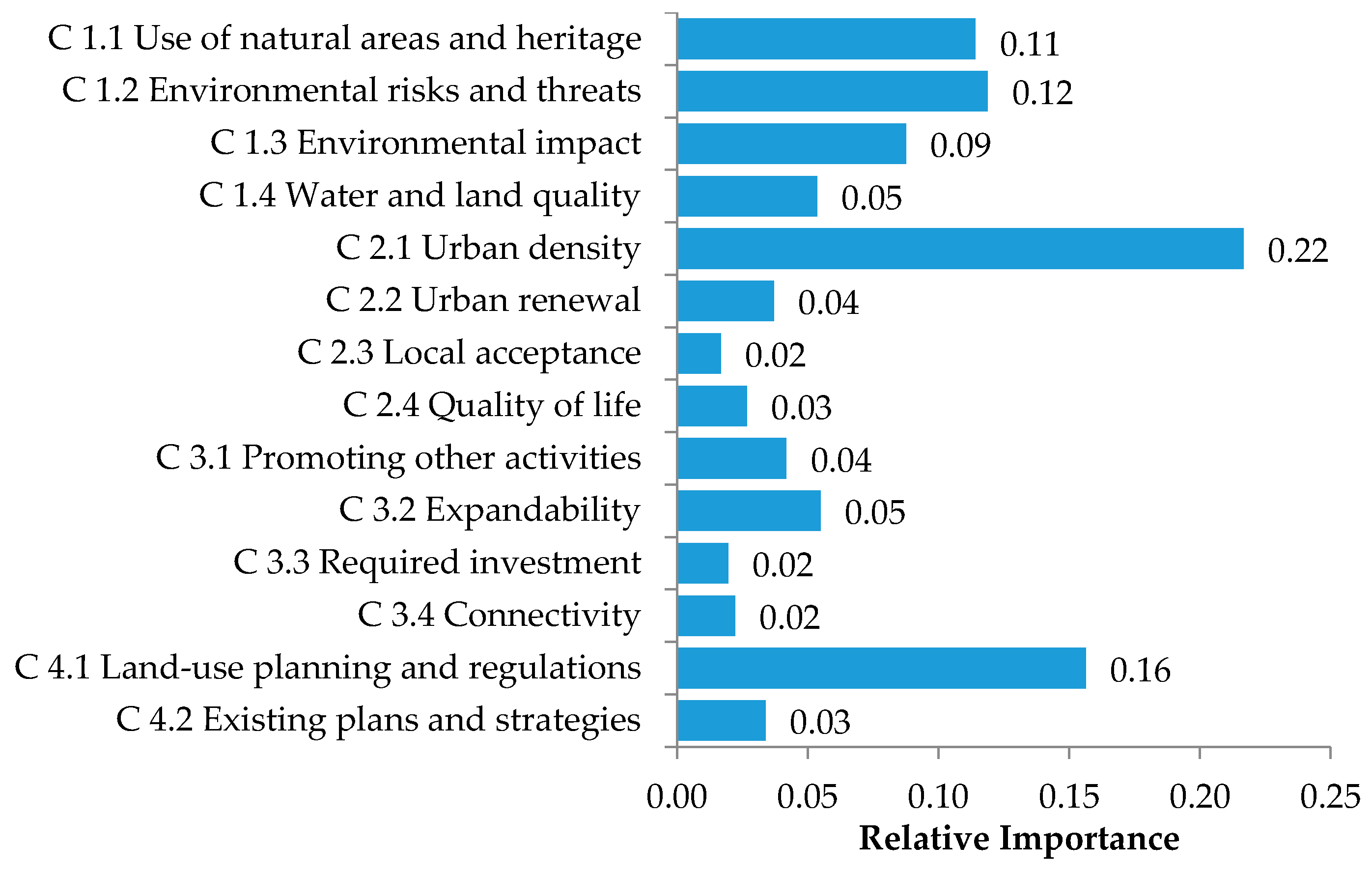
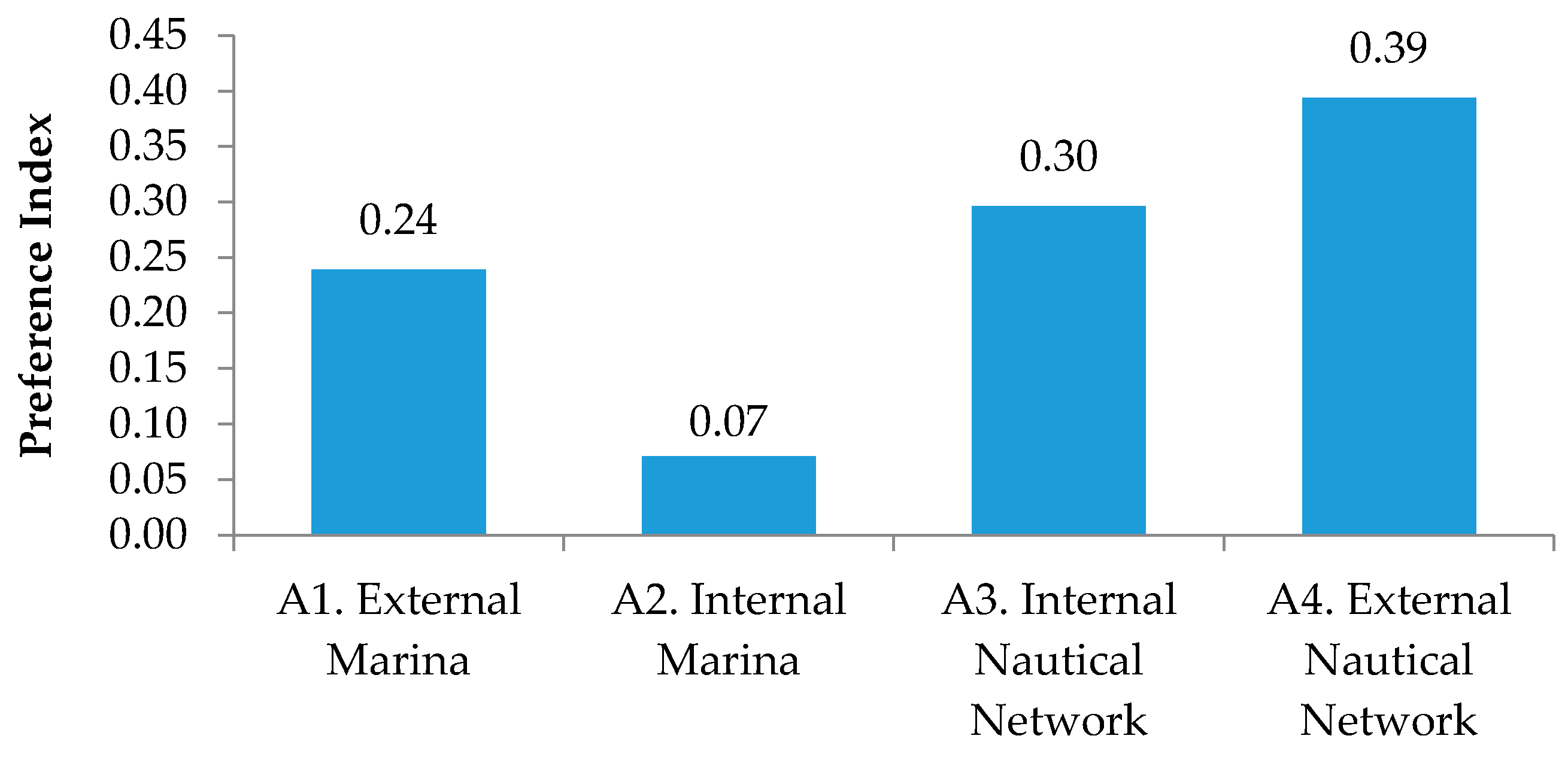
| Cluster | Definition | Criteria | Definition |
|---|---|---|---|
| Environmental | Group criteria aimed at assessing the relationship between alternatives considered and the environment. | C1.1 Use of natural spaces and material heritage. | Use of natural areas and tangible assets of the city, mainly those considered heritage. |
| C1.2 Environmental risks and threats. | Environmental risk level associated with alternatives, such as: coastal erosion, sea level rise, sea swells, floods. | ||
| C1.3 Environmental impact. | Considers the use of mangroves, water removal, solid waste production and people agglomeration. | ||
| C1.4 Water and soil quality. | Water quality of the main water body to be affected, and of the considered terrain. | ||
| Sociocultural | Assesses alternatives impact on the city’s inhabitants. | C2.1 Urban density. | Urban, commercial and industrial settlements concentration in the area. |
| C2.2 Generated urban renovation. | Possibility to generate urban renovation and recovery of spaces required by the city. | ||
| C2.3 Population acceptance. | Compatibility between the inhabitants of the zone to be impacted and the considered alternative. | ||
| C2.4 Impact on the quality of life of the population. | Impact on the quality of life of citizens in general. | ||
| Economic | It relates the potential activities to be performed to the city economy. | C3.1 Promotion of other economic activities. | Relationship with other sectors of the city’s economy. |
| C3.2 Expansion capacity. | Possibilities of long-term expansion. | ||
| C3.3 Public-private necessary investments. | Investment required for the alternatives launching. | ||
| C3.4 Connectivity with the rest of the city. | Connection with the rest of the city. | ||
| Political | Association with the city’s dispositions and plans. | C4.1 Compatibility with land-use planning and existing regulations. | Affinity of each alternative with land-use planning over the potential areas to be used by each alternative. |
| C4.2 Compatibility with local plans and other strategic initiatives of the city and the region. | Affinity of each alternative with policies, plans, projects and/or local, departmental and national existing programs. |
| 1.1 | 1.2 | 1.3 | 1.4 | 2.1 | 2.2 | 2.3 | 2.4 | 3.1 | 3.2 | 3.3 | 3.4 | 4.1 | 4.2 | A1 | A2 | A3 | A4 | |
|---|---|---|---|---|---|---|---|---|---|---|---|---|---|---|---|---|---|---|
| 1.1 | 0 | 1 | 1 | 1 | 0 | 1 | 1 | 0 | 0 | 1 | 1 | 0 | 0 | 1 | 1 | 1 | 1 | 1 |
| 1.2 | 1 | 0 | 1 | 0 | 0 | 0 | 1 | 1 | 0 | 1 | 1 | 0 | 1 | 0 | 1 | 1 | 1 | 1 |
| 1.3 | 0 | 1 | 0 | 1 | 0 | 0 | 1 | 1 | 0 | 1 | 0 | 0 | 0 | 0 | 1 | 1 | 1 | 1 |
| 1.4 | 1 | 1 | 1 | 0 | 0 | 1 | 0 | 0 | 0 | 1 | 1 | 0 | 0 | 0 | 1 | 1 | 1 | 1 |
| 2.1 | 1 | 1 | 1 | 1 | 0 | 1 | 1 | 1 | 1 | 1 | 1 | 1 | 1 | 0 | 1 | 1 | 1 | 1 |
| 2.2 | 0 | 0 | 0 | 0 | 0 | 0 | 1 | 1 | 0 | 0 | 0 | 0 | 0 | 0 | 1 | 1 | 1 | 1 |
| 2.3 | 1 | 0 | 0 | 0 | 0 | 0 | 0 | 1 | 0 | 1 | 0 | 0 | 0 | 0 | 1 | 1 | 1 | 1 |
| 2.4 | 1 | 0 | 0 | 0 | 0 | 0 | 1 | 0 | 0 | 0 | 0 | 0 | 0 | 0 | 1 | 1 | 1 | 1 |
| 3.1 | 1 | 0 | 0 | 0 | 0 | 0 | 1 | 1 | 0 | 1 | 0 | 0 | 0 | 1 | 1 | 1 | 1 | 1 |
| 3.2 | 1 | 0 | 1 | 0 | 0 | 0 | 0 | 0 | 1 | 0 | 0 | 0 | 0 | 1 | 1 | 1 | 1 | 1 |
| 3.3 | 1 | 0 | 0 | 0 | 0 | 1 | 0 | 0 | 0 | 0 | 0 | 0 | 0 | 1 | 1 | 1 | 1 | 1 |
| 3.4 | 1 | 0 | 0 | 0 | 0 | 0 | 1 | 1 | 1 | 1 | 1 | 0 | 0 | 1 | 1 | 1 | 1 | 1 |
| 4.1 | 1 | 0 | 0 | 0 | 1 | 1 | 1 | 0 | 0 | 1 | 1 | 0 | 0 | 1 | 1 | 1 | 1 | 1 |
| 4.2 | 1 | 0 | 0 | 0 | 0 | 1 | 1 | 0 | 1 | 1 | 1 | 0 | 0 | 0 | 1 | 1 | 1 | 1 |
| A1 | 1 | 1 | 1 | 1 | 1 | 1 | 1 | 1 | 1 | 1 | 1 | 1 | 1 | 1 | 0 | 0 | 0 | 0 |
| A2 | 1 | 1 | 1 | 1 | 1 | 1 | 1 | 1 | 1 | 1 | 1 | 1 | 1 | 1 | 0 | 0 | 0 | 0 |
| A3 | 1 | 1 | 1 | 1 | 1 | 1 | 1 | 1 | 1 | 1 | 1 | 1 | 1 | 1 | 0 | 0 | 0 | 0 |
| A4 | 1 | 1 | 1 | 1 | 1 | 1 | 1 | 1 | 1 | 1 | 1 | 1 | 1 | 1 | 0 | 0 | 0 | 0 |
| Cluster | Importance | Criteria | Importance |
|---|---|---|---|
| 1. Environmental | 0.374 | C1.1 Use of natural areas and heritage | 0.114 |
| C1.2 Environmental risks and threats | 0.119 | ||
| C1.3 Environmental impact | 0.088 | ||
| C1.4 Water and land quality | 0.054 | ||
| 2. Sociocultural | 0.297 | C2.1 Urban density | 0.217 |
| C2.2 Urban renewal | 0.037 | ||
| C2.3 Local acceptance | 0.017 | ||
| C 2.4 Quality of life | 0.027 | ||
| 3. Economic | 0.138 | C3.1 Promoting other activities | 0.042 |
| C3.2 Expandability | 0.055 | ||
| C3.3 Required investment | 0.019 | ||
| C3.4 Connectivity | 0.022 | ||
| 4. Political | 0.190 | C4.1 Land-use planning and regulations | 0.156 |
| C4.2 Existing plans and strategies | 0.034 |
© 2017 by the authors. Licensee MDPI, Basel, Switzerland. This article is an open access article distributed under the terms and conditions of the Creative Commons Attribution (CC BY) license (http://creativecommons.org/licenses/by/4.0/).
Share and Cite
Gonzalez-Urango, H.; García-Melón, M. A Multicriteria Model to Evaluate Strategic Plans for the Nautical and Naval Industry in Cartagena de Indias, Colombia. Sustainability 2017, 9, 653. https://doi.org/10.3390/su9040653
Gonzalez-Urango H, García-Melón M. A Multicriteria Model to Evaluate Strategic Plans for the Nautical and Naval Industry in Cartagena de Indias, Colombia. Sustainability. 2017; 9(4):653. https://doi.org/10.3390/su9040653
Chicago/Turabian StyleGonzalez-Urango, Hannia, and Mónica García-Melón. 2017. "A Multicriteria Model to Evaluate Strategic Plans for the Nautical and Naval Industry in Cartagena de Indias, Colombia" Sustainability 9, no. 4: 653. https://doi.org/10.3390/su9040653
APA StyleGonzalez-Urango, H., & García-Melón, M. (2017). A Multicriteria Model to Evaluate Strategic Plans for the Nautical and Naval Industry in Cartagena de Indias, Colombia. Sustainability, 9(4), 653. https://doi.org/10.3390/su9040653






